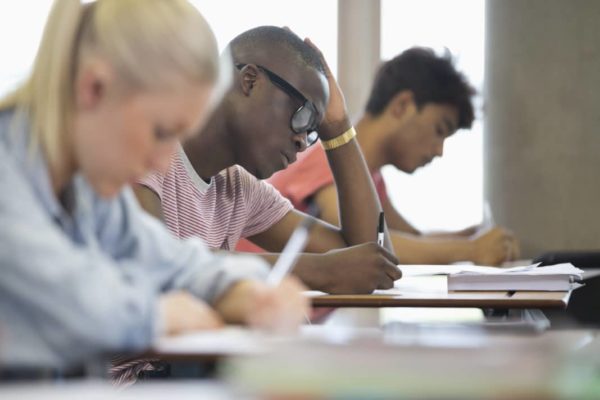
In a time of increased standardized testing, Golden argued that software used by schools help maintain separate and unequal educational opportunities. (Photo by David Schaffer/Getty Images)
Headline after headline proclaims the news: America’s students attend “failing” schools. Government data supports the conclusion. Parents agree. On this issue, liberals and conservatives are united in their dismay. The concern seems warranted because without effective schools, students will be ill-prepared for adult life.
Beginning with the release of the “A Nation at Risk” report in 1983, the federal government has tried to find ways to hold schools accountable for their results. This movement reached its zenith when President George W. Bush signed the No Child Left Behind Act in 2002. The biggest change brought by NCLB was its testing requirements. NCLB required states to administer annual standardized tests in reading, math, and science to students in grades three through eight in order to determine if schools had reached a “proficient” level on these tests. The adoption of federal standards was supposed to make it easier to determine which schools were struggling. However, because NCLB allowed states to define “proficiency,” the results vary widely from state to state. While NCLB was replaced with the Every Student Succeeds Act, that law retained the testing requirements and accountability provisions.
Under either metric, one thing is clear: schools with student populations that are primarily Black or primarily poor are most likely to be deemed failing. A report from the University of Washington studied schools in 50 cities and found that white students were four times more likely to be enrolled in top-scoring schools. Specifically, the report found that in Newark 6 percent of Black students were enrolled in a top-scoring elementary school, whereas 85 percent of white students attended such schools. Similarly, in Portland, Oregon, and Seattle, Washington, Black students were four times more likely to be enrolled in schools with math scores that placed them in the bottom quintile. Similar results have been reported in cities such as New Orleans and Chicago. Indeed, in Alabama, all of the schools deemed failing have majority-Black student populations.
The problem of failing schools is a knife that cuts both ways. On the one hand, the role that racism plays in which schools fail and which students attend those schools cannot be ignored. Standardized tests have a long and well-documented history of race and class bias. Additionally, the National Center for Education Statistics notes in the 2014-15 school year, 45 percent of Black students attended high-poverty schools, which was nearly twice the national average of 24 percent. As noted by Dr. Cynthia Hundley in a feature for the American Psychological Association, high-poverty schools face many factors that negatively impact student learning: missing supplies, outdated technology, deteriorating buildings, and the like. Moreover, the Educational Testing Service (the makers of the SAT and other tests), notes that teachers in high-poverty schools are less experienced, less likely to be certified, and more likely to leave. It is unsurprising that a study by the Economic Policy Institute found that students who attended high-poverty schools consistently had lower test scores than those that did not. So, students and staff at high-poverty schools are facing nearly insurmountable odds as they attempt to achieve their goals.
On the other hand, focusing on the obstacles ignores the fact that even under adverse circumstances, Black students are capable of learning and even excelling. Indeed, new research from Stanford University indicates that over time, students in disadvantaged neighborhoods with low test scores in third grade actually learned more over time. For example, in Chicago, students completed six years of learning in five years. Learning is possible even in challenging environments.
While it is well known that the brightest few will always succeed against any odds, educators and students across the nation have found ways to help entire schools succeed in high-poverty environments. These schools, labeled high performing high poverty schools (“HPHP” for short), help students overcome the odds they face. A report from American Public Media highlights schools in Miami and Pasadena, California. The School News Network identified a school in Grand Rapids, Michigan. The Center for American Progress found HPHP schools in Houston, Texas. Public Agenda, an educational nonprofit, found a number of HPHPs in Ohio. The Hechinger Report discovered HPHPs in Mississippi. HPHPs also exist in Wisconsin. Schools from South Texas were profiled in US News and World Report.
If it is possible to achieve in a challenging environment, why aren’t more schools making the adjustments necessary to succeed?
A wide range of researchers and organizations — including the Center for Public Education, Public Agenda, ASCD, the College of Education at Michigan State University, the Washington State Office of Public Instruction, professors at Center for School Improvement at Boise State University, and others — have studied this issue. While each researcher identified a different number of factors, when they are reviewed together, the following factors appear in all of the research:
- High Expectations For All Students
- Effective School Leadership
- High Levels Of Collaboration Between Teachers
- Good Communication Between Teachers And Administrators
- Rigorous Curriculum
The improvements do not seem difficult to implement, yet many schools have failed to incorporate them. However, there may be some explanations for the difficulties.
The first factor, high expectations, is complicated by race. Studies in various journals have documented the fact that white teachers have lower expectations for nonwhite students. A study in the journal Education Week found that while 58 percent of white teachers expected white students to graduate, they only expected 37 percent of their Black students to get diplomas. A recent Educational Foundation report noted that 87 percent of teachers are white while only 8 percent are African-American. This racial imbalance means that it is critical for white teachers to learn not only how to teach their subjects, but how to teach students that are culturally different. The report notes that when white teachers engage in “deficit thinking” — entering the classroom with the assumption that Black students are less able to learn — Black students’ outcomes suffer. Indeed, low expectations are just one reason why a Johns Hopkins study found that Black students are more likely to graduate when they have African-American teachers. High-poverty schools cannot become high performing schools if white teachers weigh down their students with low expectations.
Effective school leadership is another key factor. Research shows that principals of HPHP schools are “transformative,” and create environments where both students and staff feel supported. While researchers led by Dr. Gregory Branch have found that the presence of an effective principal impacts student outcomes. Additionally, a study from the University of North Carolina found that principals at high-poverty schools had lower qualifications for the position than their peers at low poverty institutions. Without strong qualified leadership, many of the other reforms will be difficult to implement.
Karin Chenoweth is the writer-in-residence at The Education Trust, a non-profit dedicated to promoting high academic achievement for students. Ms. Chenoweth has written three books on the characteristics of HPHP schools. She argues that the traditional ways of running schools replicate conditions what cause poverty and outcomes to be linked. In an interview with Atlanta Black Star Chenoweth said the traditional method of running schools is “individual teachers working in isolated classrooms.” She maintains that when teachers are isolated, “They can be working very hard — even extremely hard — but still not be able to teach all their students everything about the content that students need to know, the pedagogy of how to teach it, and enough about their students and students’ lives to be able to teach them. It is only through deep collaboration with their colleagues in their schools and sometimes across schools that teachers can ensure that all their students learn what they need.”
However, this change from the traditional approach to a new one is not simple. According to Chenoweth, it requires that schools reorganize “in such a way that makes working together in that way both possible and productive.” She found that this includes knowing what is needed, building schedules that allow teachers to collaborate, and “building communities of respect and calm so that students can learn and teachers can teach. And they need to build communities of trust so that teachers are not afraid to talk about their failures but instead see them as opportunities to learn.” However, she noted that principals have not been trained for these tasks, but rather, “to act something as middle managers, responsible for implementing district policies and making sure the buildings ran without too many crises and without too many parents complaining.”
Chenoweth observed, “It will take a concerted effort to change the way the education field thinks of principals.” She noted, however, that there is a growing movement to provide principals with the necessary training.
Dr. Nicole Simon is the research affiliate for The Project on the Next Generation of Teachers at the Harvard Graduate School of Education. Her work at the Project has focused on identifying practices that work in high-poverty schools and studying the working environment. One of her studies found that at low-performing schools principals were far less likely to spend an adequate amount of time reviewing teachers and frequently were not qualified in the subject they were observing. In an interview, she noted that schools were able to better evaluate teachers by prioritizing instruction, developing a culture of feedback, and reorganizing the work of principals.
Dr. Simon also noted that we cannot underestimate the difficulty faced by those leading high-poverty schools. She said, “I don’t think that the problem is that principals (or teachers, for that matter) are not qualified, I think it is that that job as we define it in America is impossible, particularly in schools where students are behind academically, in great need socio-emotionally, and where communities depend on the school for many things. As a society, we are very quick to assume that all the problems lie with the individuals directly responsible for the work, but we don’t examine whether and how those who work in schools and education are set up for success.”
Many of the remaining standards focus on teachers creating or implementing curriculum design. However, an older report from the Brookings Institution found that a teacher’s expertise “as measured by scores on licensing examinations, master’s degrees, and experience,” is the most important variable for student achievement. However, nonwhite students are far less likely to be assigned to effective, experienced teachers. A 2016 study found that Black and Latino students were roughly two times more likely than white children to attend schools where more than twenty percent of the teachers were in their first year of teaching. Moreover, the Raleigh News & Observer found that Wake County teachers were more likely to transfer out of high poverty schools in favor of low poverty schools. Of course, the loss of an experienced teacher leads to an empty slot which, according to the article, will likely be filled by a rookie teacher, or per the Washington Post, perhaps a permanent substitute. Either way, without a well-qualified, experienced teacher in the room, students suffer.
There is a well-known recipe for turning high poverty schools into high achieving schools. If policymakers and activists focus on ensuring that each school has the funding, tools, and personnel to put these practices into effect, in time, neither the schools nor the students will be deemed failures.


